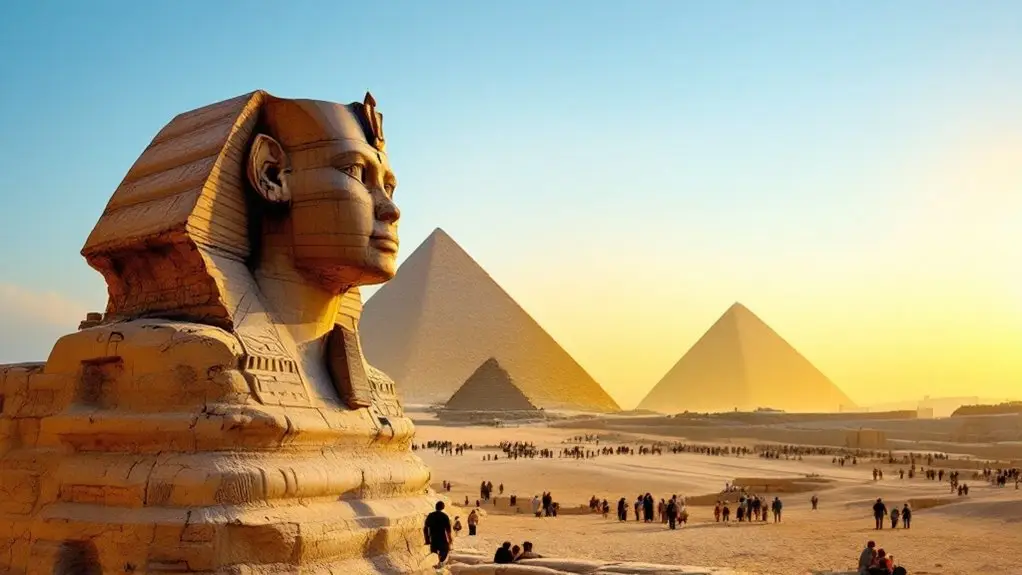Isn't it fascinating how the earth can hold whispers of our past? As you explore Africa's archaeological treasures, you'll uncover sites that not only shape our understanding of human history but also challenge the narratives we've been told. From the ancient echoes of Olduvai Gorge to the majestic remnants of the Valley of the Kings, each location offers a unique glimpse into civilizations that once thrived. What stories do these remarkable sites hold, and how might they alter your perception of Africa's role in global heritage?
Key Takeaways
- Olduvai Gorge, Tanzania: A crucial site for human evolution, revealing over 60 hominin fossils and early tools dating back 2.1 million years.
- Laetoli, Tanzania: Famous for 3.6 million-year-old hominid footprints, providing evidence of early bipedalism attributed to Australopithecus afarensis.
- Sterkfontein Caves, South Africa: Home to over 500 hominid remains, including the complete Australopithecus skull known as Mrs. Ples, dating 3.67 million years.
- Valley of the Kings, Egypt: An ancient burial site featuring elaborate tomb architecture and treasures, including artifacts from Tutankhamun's tomb, illuminating Egyptian culture.
- Great Zimbabwe: An architectural marvel from the 11th to 15th centuries, showcasing advanced stone masonry and significant trade networks in Africa.
Olduvai Gorge, Tanzania
As you explore Olduvai Gorge in Tanzania, you'll encounter one of the most important archaeological sites in the world, where the story of human evolution unfolds over a staggering 2.1 million years. This gorge offers an unparalleled continuous record of our ancestral past, showcasing fossil remains of over 60 hominins.
Remarkably, paleo-anthropologist Mary Leakey discovered critical artifacts here, including an early hominin skull fragment in 1959, which reshaped our understanding of human ancestry.
The archaeological findings at Olduvai Gorge reveal crucial insights into early human behavior. Evidence indicates that our ancestors were both scavengers and hunters, highlighting their adaptability to shifting environments.
Furthermore, the various types of stone tools unearthed at the site reflect significant technological advancements. These tools not only illustrate practical skills but also suggest complex social structures among early humans.
Olduvai Gorge serves as an essential reference point for paleoanthropologists studying the progression of human evolution. The discoveries made in this remarkable location contribute to our understanding of how hominid species developed, making it an indispensable site in the narrative of humanity's journey through time.
Valley of the Kings, Egypt
When you explore the Valley of the Kings, you'll see how tomb architecture reveals the ancient Egyptians' intricate beliefs about the afterlife.
Each burial site, with its elaborate designs and rich hieroglyphics, serves as a proof of the cultural practices of the time.
Discovering artifacts like those from Tutankhamun's tomb not only showcases historical significance but also provides invaluable insights into a civilization that continues to captivate the world.
Tomb Architecture Significance
The tomb architecture of the Valley of the Kings reveals a profound understanding of ancient Egyptian beliefs regarding death and the afterlife. This architectural marvel served as more than just burial sites; they were elaborate sanctuaries designed to protect and honor the deceased. The intricate layouts and decorations encapsulate the essence of royal burial practices, ensuring a safe passage to the next world.
Key aspects of this tomb architecture include:
- Complex designs: Featuring hidden chambers and intricate corridors aimed at thwarting grave robbers.
- Advanced engineering: Employing traps and false doors to safeguard funerary artifacts.
- Cultural reflections: Inscriptions and wall paintings that depict religious rituals and daily life.
- Symbolic decorations: Artwork that illustrates the deceased's journey to the afterlife.
- Historical significance: Notable tombs, such as Tutankhamun's, have provided invaluable insights into ancient Egypt's royal customs.
Through these elements, the tombs of the Valley of the Kings not only showcase architectural prowess but also illuminate the spiritual beliefs and cultural practices of a civilization that continues to fascinate the world.
Historical Artifacts Discovery
Discoveries of historical artifacts in the Valley of the Kings illuminate the grandeur and intricacy of ancient Egyptian civilization. Serving as the burial site for pharaohs and nobility during the 2nd millennium BC, this important archaeological site has revealed 63 tombs, many of which, regrettably, have faced looting.
Notable archaeological discoveries, such as the largely intact tomb of Tutankhamun found in 1922, showcase the wealth and artistry of ancient Egypt, offering a glimpse into the gold trade and elaborate funerary customs.
The intricately designed tombs often contain exquisite wall paintings and hieroglyphics, depicting the deceased's journey to the afterlife, which underscores the significance of this belief in ancient Egyptian culture. These artifacts not only reflect the skills of human ancestors but also provide valuable insights into the socio-political dynamics of the time.
Ongoing archaeological efforts continue to unearth hidden chambers and previously unknown tombs, expanding our understanding of ancient Egyptian history. Each discovery contributes a piece to the puzzle, revealing the complexities of a civilization that thrived thousands of years ago.
The Valley of the Kings remains a symbol of the enduring legacy of ancient Egypt.
Cultural Practices Reflection
Uncovering the tombs in the Valley of the Kings reveals not just artifacts but the profound cultural practices that defined ancient Egyptian society. This ancient city, serving as a burial site for pharaohs and nobles, reflects the Egyptians' complex beliefs regarding the afterlife.
The architectural splendor of the tombs indicates a society that prioritized elaborate burial customs, showcasing the importance of the deceased's journey beyond life.
Key cultural practices evident in the Valley include:
- Belief in the afterlife: The tombs served as gateways for the souls of the deceased.
- Elaborate burial goods: Items buried with the dead signify wealth and status.
- Artistic expression: Wall paintings and inscriptions convey religious beliefs and political narratives.
- Community involvement: The tombs were a shared cultural project, reflecting societal values.
- Historical significance: The Valley has attracted visitors since antiquity, underscoring its lasting impact.
Gedi Ruins, Kenya
Thriving between the 13th and early 17th centuries, the Gedi Ruins in Kenya stand as a monument to the architectural and cultural achievements of the coastal Swahili civilization. This historical site, encompassing approximately 45 acres, features impressive structures like a large mosque and magnificent stone houses, showcasing the advanced architectural techniques of the time.
As a prominent trading hub, Gedi engaged in commerce with far-off regions, including Spain, Venice, India, and China. Archaeological findings unearthed since excavations began in the 1940s reveal artifacts that provide significant insights into the daily life, trade practices, and cultural significance of the Swahili people. Each discovery adds depth to our understanding of the interconnectedness of ancient economies and cultures.
Surrounded by a dense forest, the Gedi Ruins benefit from natural preservation, adding an air of mystery to the site. Recognized as a national monument and included on UNESCO's World Heritage tentative list, Gedi's importance extends beyond its physical remnants, serving as an essential link to the rich history and cultural legacy of the coastal Swahili civilization.
Laetoli, Tanzania
Shifting from the architectural marvels of the Gedi Ruins, Laetoli in Tanzania presents a striking glimpse into the early stages of human evolution.
Discovered in 1976 by paleoanthropologist Mary Leakey, the site is renowned for its hominid footprints preserved in volcanic ash, dating back approximately 3.6 million years. These footprints, attributed to Australopithecus afarensis, provide essential evidence of early bipedalism, showcasing the remarkable ability of our ancestors to walk upright.
The archaeological significance of Laetoli extends beyond human tracks. You'll also find footprints from various animals, enriching your understanding of the ecosystem at that time.
Here are some key aspects of Laetoli:
- Footprints of Australopithecus afarensis: Evidence of early human bipedalism.
- Volcanic ash preservation: Key to the remarkable state of the footprints.
- Animal tracks: Insights into the diverse fauna of the era, including hyenas and gazelles.
- Contextual significance: Part of the broader archaeological narrative of Olduvai Gorge.
- Impact on anthropology: A transformative discovery in understanding human evolution.
Laetoli stands as an essential link to our distant past, illuminating the path of human ancestry.
Sterkfontein Caves, South Africa
The Sterkfontein Caves in South Africa offer a fascinating glimpse into our evolutionary past, housing one of the richest collections of hominid fossils in the world. Nestled within the Cradle of Humankind UNESCO World Heritage Site, these caves have been pivotal in shaping our understanding of human evolution. Since excavations began in the mid-1930s, around 500 hominid remains have been uncovered, providing invaluable insights into our ancestry.
Among the most significant discoveries is Mrs. Ples, the most complete Australopithecus skull ever found, which has helped researchers piece together the physical characteristics of early hominins.
Another remarkable find, Little Foot, represents one of the most complete early hominid skeletons, dating back approximately 3.67 million years. These fossils reveal not only the biological evolution of our species but also reflect the complex social behaviors and environmental adaptations that early hominins exhibited.
The Sterkfontein Caves therefore stand as a monument to the intricate journey of evolution, illuminating the path that led to modern humans. They serve as a reminder of our shared heritage and the environmental contexts that shaped our development.
Meroe, Sudan
Situated along the banks of the Nile River, Meroe, Sudan, emerges as a remarkable proof of the ancient Kingdom of Kush. Established around 800 BC, Meroe served as a vibrant capital and became a prominent trading hub, connecting various cultures, including Egypt, Greece, and Rome. Its strategic location along the Nile facilitated commerce, greatly influencing the region's economy.
The archaeological discoveries in Meroe reveal much about Kushitic civilization. Here are some key features that define this historical site:
- Pyramids: Over 200 unique pyramids showcase the architectural prowess of the Kushites.
- Temples: Structures dedicated to various deities highlight the spiritual life of the Nubians.
- Palaces: Remnants of royal residences provide insights into the political organization of the Kingdom.
- Artifacts: Everyday items unearthed shed light on the daily lives of Meroe's inhabitants.
- Trade Routes: Evidence of trade networks illustrates Meroe's role as a commercial center.
Despite its decline in the 3rd century AD due to trade disruptions and invasions, Meroe remains a crucial link to understanding the rich heritage of ancient Nubian society.
Great Zimbabwe
Great Zimbabwe stands as striking evidence of the ingenuity of ancient African civilizations, showcasing a sophisticated society that thrived between the 11th and 15th centuries. As a UNESCO World Heritage Site, this remarkable location was the capital of a prosperous trading empire, home to a population of 10,000 to 20,000 people.
Dating back to around AD 900, Great Zimbabwe developed advanced stone masonry techniques, highlighted by the impressive Great Enclosure, featuring 10-meter high walls and towers.
At its peak, from AD 1300 to 1500, Great Zimbabwe controlled over 39,000 square miles and produced an estimated 600 tonnes of gold, making it a vital player on the African continent's trading landscape.
The site hosts significant structures like the Hill Complex and the Great Enclosure, which served both ceremonial and royal functions, illustrating the civilization's social hierarchy.
Importantly, archaeological evidence confirms Great Zimbabwe's exclusively African origins, countering earlier misconceptions that attributed its construction to foreign civilizations.
This site not only symbolizes the rich history of Africa but also reflects the skill and creativity of its people, solidifying its place as one of the continent's top archaeological treasures.
Frequently Asked Questions
What Are Some Archaeological Finds in Africa?
When exploring archaeological finds in Africa, you'll encounter ancient artifacts that reveal rich histories.
The fossil discoveries at sites like Olduvai Gorge illustrate human evolution, while burial sites in the Valley of the Kings showcase royal traditions.
You can also investigate the remnants of lost civilizations at the Gedi Ruins, alongside enthralling rock art that reflects cultural expressions.
Together, these elements paint a vivid picture of Africa's diverse and complex heritage.
What Are Africa's Two Most Valuable Minerals?
In Africa's vast treasure chest, gold and diamonds shine brightest, illuminating the continent's mineral resources.
Gold mining, steeped in history, fuels economies and symbolizes power.
Meanwhile, the diamond trade sparkles with potential, driving significant economic impact.
As you explore sustainable extraction methods, you uncover the delicate balance between wealth and environmental stewardship.
Both minerals not only enrich nations but also weave themselves into the cultural fabric of societies, embodying heritage and craftsmanship.
What Are the Oldest Things in Africa?
When you explore Africa's oldest things, you'll encounter ancient civilizations and fossil discoveries that tell the story of human evolution.
Sites like the Sterkfontein Caves reveal historical artifacts over 2 million years old, while Laas Gaal's prehistoric art, dating back to 9,000 BC, showcases cultural heritage and early human expression.
Each find offers insight into the lives of our ancestors, enriching your understanding of humanity's past and its diverse narratives.
What Is the Greatest Archaeological Finds in History?
They say, "the past is a foreign country," and it's true—great archaeological finds reveal ancient civilizations, lost cities, and cultural artifacts that connect us to our origins.
You'll discover how innovative archaeological techniques uncover layers of history, revealing prehistoric art that speaks volumes about human experience.
These findings not only reshape our understanding of ancient societies but also ignite curiosity about our shared heritage and the stories waiting to be told.
Conclusion
In exploring Africa's archaeological treasures, you uncover not just ancient ruins but the profound narratives of human history. For instance, the Olduvai Gorge is often dubbed the "Cradle of Mankind," where fossils dating back over 1.8 million years reveal the evolution of early hominins. This statistic highlights Africa's pivotal role in our understanding of human origins. By appreciating these sites, you gain insight into the complexities and continuity of civilizations that have shaped our world today.








